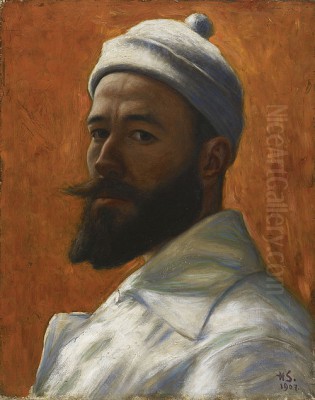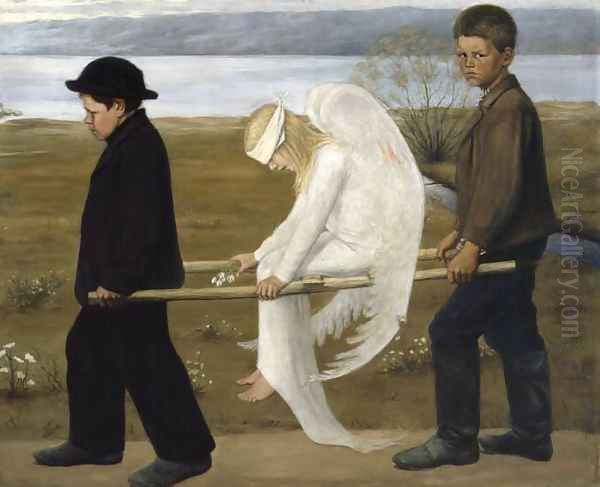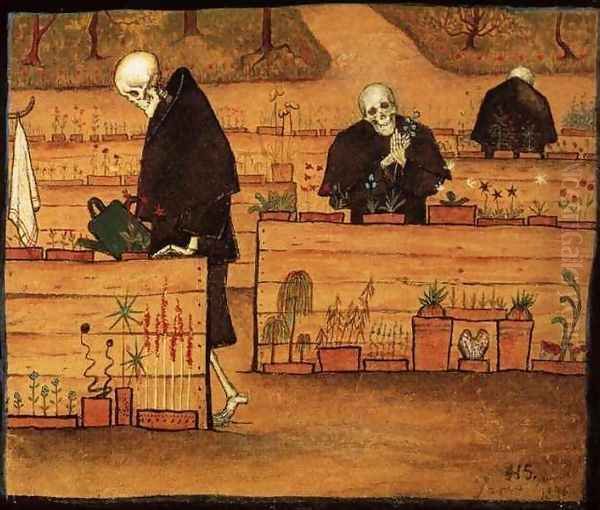
Hugo Simberg stands as one of Finland's most cherished and unique artists, a pivotal figure in the Symbolist movement whose work continues to fascinate and provoke thought. Active during the turn of the 20th century, a period often referred to as the Golden Age of Finnish Art, Simberg developed a highly personal visual language to explore profound themes of life, death, spirituality, and the subconscious. His paintings and graphic works, often characterized by a blend of naive charm, melancholy, and macabre imagery, offer a window into a world both deeply Finnish and universally human.
Born Hugo Gerhard Simberg on June 24, 1873, in Hamina (then Fredrikshamn), Finland, his artistic journey began formally in 1891. He initially enrolled at the Viipuri Friends of Art Drawing School, demonstrating an early commitment to developing his craft. His quest for deeper artistic understanding led him to Helsinki, where he studied at the Finnish Art Society's Drawing School from 1893 to 1895. This period provided him with foundational skills but ultimately left him seeking more personalized guidance.
Early Life and Artistic Formation
Simberg's early education laid the groundwork, but he felt the formal instruction lacked the depth he craved. Dissatisfied with the conventional approaches, he took a bold step. He wrote directly to Akseli Gallen-Kallela, already a towering figure in Finnish art, known for his powerful depictions of the national epic, the Kalevala, and his pioneering role in Finnish Symbolism and National Romanticism. Simberg requested to become his private student.
Gallen-Kallela accepted, and from 1895 to 1897, Simberg studied under his tutelage at Gallen-Kallela's wilderness studio, Kalela, in Ruovesi. This mentorship proved crucial. Gallen-Kallela's influence is visible in Simberg's developing technique and thematic concerns, although Simberg quickly forged his own distinct path, moving away from the heroic nationalism often associated with his teacher towards a more introspective and psychologically charged form of Symbolism. The natural surroundings of Ruovesi also deeply impacted Simberg, fostering a connection to the Finnish landscape and folklore that would permeate his work.
Travels and Broadening Horizons

Like many artists of his generation seeking broader perspectives, Simberg traveled beyond Finland's borders. He journeyed to London, Paris, and Italy between 1896 and 1910, immersing himself in the diverse artistic currents of Europe. These trips exposed him to a wealth of historical and contemporary art, from the works of the Old Masters to the burgeoning Symbolist and early Modernist movements across the continent.
His time in Paris, a major hub for Symbolism, likely brought him into contact with the ideas and works of artists like Odilon Redon and Pierre Puvis de Chavannes, whose dreamlike and allegorical paintings resonated with the direction Simberg's own art was taking. Exposure to Italian Renaissance frescoes and medieval art also left an imprint, influencing his later mural work and his interest in simplified forms and direct emotional expression. A trip to the Caucasus in 1900 provided further unique cultural experiences, though his written travelogue was unfortunately lost.
The Symbolist Vision
Hugo Simberg is best understood as a Symbolist, but his interpretation of the movement was highly individualistic. Symbolism, emerging in the late 19th century, prioritized subjective experience, emotion, and the mystical over objective reality. Artists sought to express ideas and feelings indirectly through symbols, metaphors, and suggestive imagery. Simberg embraced this ethos wholeheartedly, using his art to explore the hidden realities beneath the surface of everyday life.
His visual world is populated by a recurring cast of characters: naive devils, thoughtful skeletons, melancholic angels, and personifications of abstract concepts like Frost and Death. These figures are rarely terrifying in a conventional sense; instead, they often possess a childlike simplicity or a poignant vulnerability. Simberg's devils might be mischievous or downtrodden, his skeletons engaged in mundane tasks, blurring the lines between the earthly and the otherworldly, the humorous and the profound.
Simberg's style is characterized by a deliberate simplicity, sometimes described as naive or primitive, which enhances the emotional directness of his work. He often employed strong outlines, flattened perspectives, and a rich, sometimes somber, color palette. His technique, whether in oil painting, watercolor, or etching, was always subservient to the symbolic meaning and emotional atmosphere he wished to convey. He aimed not for realistic depiction but for the evocation of a mood, a dream, or a psychological state.
Masterpieces of Mystery
Several of Simberg's works have achieved iconic status within Finnish art history, embodying his unique vision.
The Wounded Angel

Perhaps Simberg's most famous painting, The Wounded Angel (1903), is a work of profound ambiguity and emotional resonance. It depicts two somber boys carrying a stretcher on which sits a blindfolded angel with a bloodied wing. The landscape is stark yet serene. Simberg refused to offer a definitive interpretation, preferring viewers to find their own meaning. Is it a symbol of vulnerability, innocence harmed, the fragility of life, or perhaps Finland itself? Its power lies in its evocative atmosphere and its refusal of easy answers. In 2006, it was voted Finland's "national painting" in a public poll held by the Ateneum Art Museum.
The Garden of Death
Another seminal work, The Garden of Death (1896), exists in several versions, including a watercolor and an etching. It presents a startlingly unconventional view of the afterlife. Three skeletal figures, clad in black robes, are shown diligently tending a garden filled with plants representing human souls. Far from being grim reapers, they appear as gentle, focused gardeners. The work reflects Simberg's recurring interest in death not as a terrifying end, but as a natural, perhaps even nurturing, part of existence. The imagery draws inspiration from medieval motifs but is filtered through Simberg's uniquely tender and slightly humorous sensibility.
Other Notable Works
Simberg's oeuvre includes many other significant pieces that explore his characteristic themes. Early works like Frost (1895) and Autumn (1895) personify natural forces with a blend of folklore and psychological depth, showing Gallen-Kallela's early influence combined with Simberg's emerging individuality. Death Listens (1897) portrays Death as a skeletal figure pausing by a sickbed, hand cupped to its ear, listening intently. The Poor Devil by the Fire (1897) shows a small, pathetic devil warming itself, evoking empathy rather than fear. These works consistently demonstrate Simberg's ability to imbue supernatural or allegorical figures with relatable human qualities.
The Tampere Cathedral Frescoes
Between 1905 and 1906, Simberg undertook his largest and most ambitious project: the decoration of St. John's Church in Tampere, now Tampere Cathedral. Working alongside fellow Symbolist Magnus Enckell, who handled the altarpiece, Simberg was responsible for the majority of the frescoes and stained glass designs. This commission allowed him to translate his deeply personal iconography onto a monumental public scale.
The cathedral's interior is adorned with some of Simberg's most recognizable motifs. High in the main vault snakes a serpent holding an apple, a clear reference to the Garden of Eden. The main gallery railing features The Garland of Life, carried by twelve naked boys symbolizing the apostles or the journey of life. Most famously, Simberg painted large frescoes of both The Wounded Angel and The Garden of Death within the church, adapting these easel paintings for the architectural space.
The inclusion of such unconventional, ambiguous, and even macabre imagery within a Lutheran cathedral was highly controversial at the time. Simberg's devils, skeletons, and wounded angel challenged traditional religious iconography. However, the works have since become an integral part of the cathedral's identity and are considered masterpieces of Finnish church art, showcasing Simberg's unwavering commitment to his personal vision even within a demanding public commission.
Graphic Arts and Photography
While best known for his paintings and frescoes, Simberg was also a highly accomplished graphic artist. He produced numerous etchings and woodcuts throughout his career, often exploring the same themes and motifs found in his paintings but adapted to the unique possibilities of printmaking. His graphic works, characterized by their fine lines and atmospheric intensity, allowed for wider dissemination of his imagery. The Gösta Serlachius Fine Arts Foundation holds a significant collection of his prints.
Furthermore, Simberg was an avid photographer. He used photography not only as a preparatory tool for his paintings, capturing landscapes and figure studies, but also experimented with it as an art form in its own right. His photographs often display a similar sensitivity to mood and composition as his other works. This engagement with multiple media underscores his versatile artistic talent and his modern approach to image-making.
Context: The Golden Age and Contemporaries
Hugo Simberg emerged during a vibrant period for Finnish culture known as the Golden Age of Finnish Art, roughly spanning from the 1880s to the 1910s. This era coincided with Finland's growing sense of national identity under Russian rule and saw an explosion of creativity in painting, music (Jean Sibelius), architecture (Eliel Saarinen), and literature. Artists sought to define a distinctly Finnish culture, often drawing inspiration from the national epic, the Kalevala, the Finnish landscape, and folk traditions.
Simberg was part of a remarkable generation of Finnish artists. Besides his mentor Akseli Gallen-Kallela, his contemporaries included:
Magnus Enckell: A fellow Symbolist, known for his refined aesthetic, ethereal figures, and use of color, who collaborated with Simberg on the Tampere Cathedral.
Ellen Thesleff: A pioneering modernist and Symbolist, celebrated for her expressive use of color and light.
Pekka Halonen: A painter associated with National Romanticism and Karelianism, known for his depictions of Finnish landscapes and rural life.
Eero Järnefelt: A prominent Realist and portraitist, also known for his landscapes and depictions of Finnish society.
Helene Schjerfbeck: One of Finland's most important modernists, whose work evolved from Realism towards highly abstracted self-portraits and still lifes.
While deeply rooted in the Finnish context, Simberg's work also connects to broader European Symbolist currents. His exploration of death, dreams, and the psyche echoes themes found in the work of international figures like Norway's Edvard Munch, Switzerland's Arnold Böcklin (famous for Isle of the Dead), France's Odilon Redon, Belgium's James Ensor, and potentially the mural work of Pierre Puvis de Chavannes or the symbolic figures of Swiss painter Ferdinand Hodler. Simberg synthesized these influences into a vision that remained uniquely his own.
Later Life and Legacy
In his later years, Simberg continued to work and exhibit, although his style did not undergo radical changes. He also taught, sharing his knowledge and influencing younger artists. He served on the board of the Association for Art Education (Konstverk till skolan), indicating a commitment to fostering art appreciation. His personal life remained relatively private, though his art suggests a deep engagement with human emotions like loneliness, love, and the search for meaning.
Hugo Simberg died relatively young, on July 12, 1917, in Ähtäri, Finland, at the age of 44. While respected during his lifetime, the full appreciation of his unique genius grew significantly after his death. He came to be recognized as a central figure not only in Finnish Symbolism but in the nation's entire artistic heritage. His work defied easy categorization, blending sophistication with apparent naivety, darkness with tenderness, and folk elements with profound psychological depth.
His legacy lies in his creation of a deeply personal symbolic language that continues to resonate with audiences. He dared to explore uncomfortable themes with honesty and originality, offering a perspective on life and death that is both unsettling and comforting. His influence can be seen in subsequent generations of Finnish artists who value subjective expression and psychological exploration. His works remain central to the narrative of Finnish art history and national identity.
Collections and Enduring Presence
The most significant collection of Hugo Simberg's works is held by the Finnish National Gallery, primarily displayed at the Ateneum Art Museum in Helsinki. This includes masterpieces like The Wounded Angel, The Garden of Death, Frost, and many others. His monumental frescoes remain in situ at Tampere Cathedral, a major cultural landmark. The Serlachius Museums in Mänttä also hold important works, particularly his graphic art. Smaller collections and individual pieces can be found in other Finnish museums like the Helsinki Art Museum (HAM) and the Hämeenlinna Art Museum, as well as in private hands.
Today, Simberg's work is more accessible than ever through museum exhibitions, publications, and digital archives. His enduring appeal lies in the enigmatic quality of his images and their capacity to evoke deep emotional and intellectual responses. He remains a beloved figure in Finland and an intriguing discovery for international audiences interested in the rich and complex history of Symbolist art.
Conclusion
Hugo Simberg carved a unique niche within the landscape of European Symbolism. His art is a testament to the power of personal vision, drawing from Finnish folklore, the natural world, and his own introspective imagination to create works that are simultaneously charming, melancholic, and profound. By giving visual form to the intangible realms of dreams, death, and the spirit, Simberg offered a unique perspective on the human condition. His devils, angels, and skeletons are not mere fantasy figures; they are symbols of the complex inner lives and universal anxieties that continue to define us, making his art as relevant and compelling today as it was a century ago. He remains Finland's painter of dreams and shadows, inviting viewers into a world where the mystical and the mundane coexist.